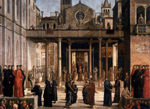 |
BASTIANI, Lazzaro The Relic of the Holy Cross is offered to the Scuola Grande di San Giovanni Evangelista c. 1494 |
Part of a cycle about the relic of the True Cross commissioned by the Scuola di San Giovanni Evangelista in 1494 or 1495. See also works by Gentile Bellini, Giovanni Mansueti, Vittore Carpaccio, and Benedetto Diana. Referring to Lazzaro Bastiani's Offering of the Relic of the True Cross: "As might be expected the painting includes a considerable number of Venetian gentlemen wearing their gowns and bechi and, rather surprisingly within the church, their black caps. There are a few women in the background and two in the middle distance, while in the foreground stand two men in a very unusual style of dress, possibly Hungarian."[1] |
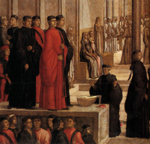 |
BASTIANI, Lazzaro The Relic of the Holy Cross is offered to the Scuola Grande di San Giovanni Evangelista, detail c. 1494 |
|
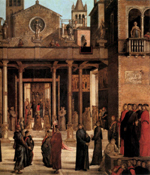 |
BASTIANI, Lazzaro The Relic of the Holy Cross is offered to the Scuola Grande di San Giovanni Evangelista, detail c. 1494 |
|
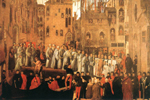 |
MANSUETI, Giovanni Miracle of the Relic of the Holy Cross in Campo San Lio c. 1494 |
Part of a cycle about the relic of the True Cross commissioned by the Scuola di San Giovanni Evangelista in 1494 or 1495. See also works by Gentile Bellini, Vittore Carpaccio, Lazzaro Batiani and Benedetto Diana. |
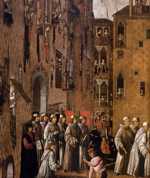 |
MANSUETI, Giovanni Miracle of the Relic of the Holy Cross in Campo San Lio, detail c. 1494 |
|
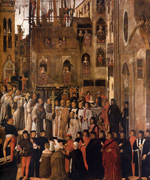 |
MANSUETI, Giovanni Miracle of the Relic of the Holy Cross in Campo San Lio, detail c. 1494 |
|
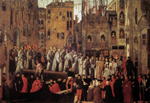 |
MANSUETI, Giovanni Miracle of the Relic of the Holy Cross in Campo San Lio, detail c. 1494 |
|
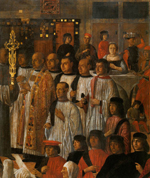 |
MANSUETI, Giovanni Miracle of the Relic of the Holy Cross in Campo San Lio, detail c. 1494 |
|
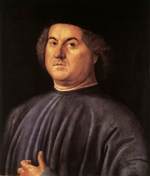 |
VIVARINI, Alvise |
|
 |
BARBARI, Jacopo de' Plan of Venice 1500 Museo Correr, Venice |
Woodcut produced with six blocks. A detail of this scene is the background image on this webpage. |
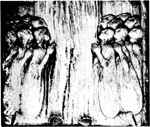 |
ANONYMOUS |
"Members of the confraternity of Furriers kneel at the feet of the Virgin, wearing their livery, with its large sleeves a comeo."[2] |
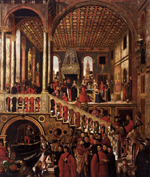 |
MANSUETI, Giovanni The Miraculous Healing of the Daughter of Benvegnudo of San Polo c. 1505 |
|
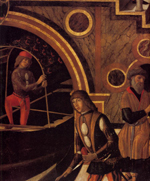 |
MANSUETI, Giovanni The Miraculous Healing of the Daughter of Benvegnudo of San Polo, detail c. 1505 |
|
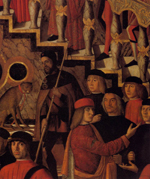 |
MANSUETI, Giovanni The Miraculous Healing of the Daughter of Benvegnudo of San Polo, detail c. 1505 |
|
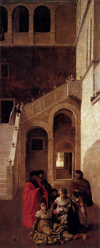 |
DIANA, Benedetto Miracle of the Relic of the Holy Cross 1505-10 |
Part of a cycle about the relic of the True Cross commissioned by the Scuola di San Giovanni Evangelista in 1494 or 1495. See also works by Gentile Bellini, Giovanni Mansueti, Vittore Carpaccio, and Lazzaro Batiani. "As can be seen from the simplicity of her dress and hairstyle, the mother of the baby miraculously saved after falling from a height is a cittadina . The lines of her dress and its tied-in sleeve are, nevertheless, fashionable. They belong to the early years of the sixteenth century. Her left zoccolo stands on the ground beside her."[3] |
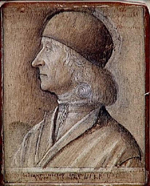 |
BELLINIANO, Vittore Giovanni Bellini 1505 |
|
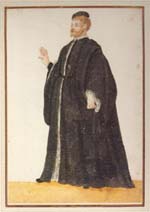 |
A Magnifico with a black robe from Mores Italiae (MS 457) 1573-78 Yale University, Beinecke Library |
The image shows the usual dress of the Venetian nobility: a robe (in Venetian, a vesta) that in winter was lined with vair (Vecellio). The sleeves were loose and could end in cuffs that were either close-fitting (a còmeo) or wide (alla dogalina). On his right shoulder the nobleman wears the sash with identifies his public office. The 'pan-shaped' beret was usually only worn on official occasions. Black clothes were also the privilege of certain professions, foremost amongst which were those associated with the unversity."[4] "Mores Italiae, a travel album containing richly-coloured costumes and dynamic and entertaining scenes of daily life, was compiled most likely by a foreign student at the University of Padua in the 1570s, during his pre-Grand Tour travels through Western Europe."[5] |
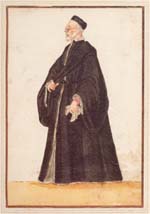 |
A doctor of law or medicine, perhaps a university professor from Mores Italiae (MS 457) 1573-78 Yale University, Beinecke Library |
"Given the similarities in wardrobe with the figure shown on f. 10, this too may well be a university teacher, perhaps a professor of law or medicine. Here again, the pretina gown with its long 'a comeo' sleeves (full below the elbow then gathered at the wrist) is worn with a stole. Both of these are in black, as is the 'pan-shaped' hat which such figures wore on official occasions."[6] |
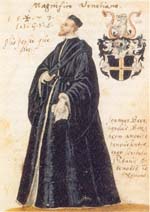 |
Magnifico Venetiano from Egerton MS 1191 1573-78 British Library |
"The portrait of a "Magnifico Venetiano" with a motto in French, "Plus penser que dire," and a signature, "Johannes Bernardu Bonheim amores e benevolentiae ergo scribebat in Patavii Antenoris 10 Novembre," are placed in the lower right-hand corner underneath a coat of arms in Egerton MS 1191. A similar image, without a caption, is included in Mores Italiae, f. 19 [43].... Both wear a long floor-length black gown, a black cap, and black velvet cape. The gown, closed in the front, if fastened with a thin, unobtrusive tie, and there is only a narrow strip of white shirt at the neck. Under the gown, these male officials wear black hose, a silk doublet, and sandal like shoes."[7] |
References
1. Stella Mary Newton, The Dress of the Venetians, 1495-1525 (Aldershot, England: Scolar Press, 1988), 140.
4. Maurizio Rippa Bonati and Valeria Finucci, eds., Mores Italiae: costumi e scene di vita del Rinascimento = Costume and Life in the Renaissance: Yale University, Beinecke Library, MS 457 (Cittadella, Padova: Biblos, 2007), fig. 10.